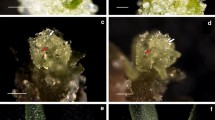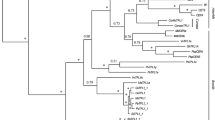Abstract
The FT/TFL1 gene family encodes proteins with similarity to phosphatidylethanolamine binding proteins which function as flowering promoters and repressors. We show here that the FT/TFL1 gene family in Vitis vinifera is composed of at least five genes. Sequence comparisons with homologous genes identified in other dicot species group them in three major clades, the FT, MFT and TFL1 subfamilies, the latter including three of the Vitis sequences. Gene expression patterns are in agreement with a role of VvFT and VvMFT as flowering promoters; while VvTFL1A, VvTFL1B and VvTFL1C could be associated with vegetative development and maintenance of meristem indetermination. Overexpression of VvFT in transgenic Arabidopsis plants generates early flowering phenotypes similar to those produced by FT supporting a role for this gene in flowering promotion. Overexpression of VvTFL1A does not affect flowering time but the determination of flower meristems, strongly altering inflorescence structure, which is consistent with the biological roles assigned to similar genes in other species.




Similar content being viewed by others
Abbreviations
- SAM:
-
shoot apical meristem
References
Abe M, Kobayashi Y, Yamamoto S, Daimon Y, Yamaguchi A, Ikeda Y, Ichinoki H, Notaguchi M, Goto K, Araki T (2005) FD, a bZIP protein mediating signals from the floral pathway integrator FT at the shoot apex. Science 309:1052–1056
Ahn JH, Miller D, Winter VJ, Banfield MJ, Lee JH, Yoo SY, Henz SR, Brady RL, Weigel D (2006) A divergent external loop confers antagonistic activity on floral regulators FT and TFL1. EMBO J 25:605–614
Ausín I, Alonso-Blanco C, Martínez-Zapater JM (2005) Environmental regulation of flowering. Int J Dev Biol 49:689–705
Baggiolini M (1952) Les stades repères dans le développement de la vigne et leur utilisation pratique. Rev Romande Agric Vitic Arbor 8:4–6
Banfield MJ, Brady RL (2000) The structure of Antirrhinum CENTRORADIALIS protein (CEN) suggests a role as a kinase regulator. J Mol Biol 297:1159–1170
Böhlenius H, Huang T, Charbonnel-Campaa L, Brunner AM, Jansson S, Strauss SH, Nilsson O (2006) CO/FT regulatory module controls timing of flowering and seasonal growth cessation in trees. Science 312:1040–1043
Boss PK, Sreekantan L, Thomas MR (2006) A grapevine TFL1 homologue can delay flowering and alter floral development when overexpressed in heterologous species. Funct Plant Biol 33:31–41
Boss PK, Bastow RM, Mylne JS, Dean C (2004) Multiple pathways in the decision to flower: enabling, promoting, and resetting. Plant Cell 16(Suppl):S18–31
Bradley D, Carpenter R, Copsey L, Vincent C, Rothstein S, Coen E (1996) Control of inflorescence architecture in Antirrhinum. Nature 379:791–797
Bradley D, Ratcliffe O, Vincent C, Carpenter R, Coen E (1997) Inflorescence commitment and architecture in Arabidopsis. Science 275:80–83
Brunner AM, Nilsson O (2004) Revisiting tree maturation and floral initiation in the poplar functional genomics era. New Phytol. 164:43–51
Calonje M, Cubas P, Martínez-Zapater JM, Carmona MJ (2004) Floral meristem identity genes are expressed during tendril development in grapevine. Plant Physiol 135:1491–1501
Carmel-Goren L, Liu YS, Lifschitz E, Zamir D (2003) The SELF PRUNING gene family in tomato. Plant Mol Biol 52:1215–1222
Carmona MJ, Cubas P, Martínez-Zapater JM (2002) VFL, the grapevine FLORICAULA/LEAFY ortholog, is expressed in meristematic regions independently of their fate. Plant Physiol 130:68–77
Carmona MJ, Cubas P, Calonje M, Martínez-Zapater JM (2007) Flowering transition in grapevine (Vitis vinifera L.). Can J Bot (in press)
Chang S, Puryear J, Cairney J (1993) A simple and efficient method for isolating RNA from pine trees. Plant Mol Biol Rep 11:113–116
Chardon F, Damerval C (2005) Phylogenomic analysis of the PEBP gene family in cereals. J Mol Evol 61:579–590
Church JM, Gilbert W (1984) Genomic sequencing. Proc Natl Acad Sci USA 81:1991–1995
Clough SJ, Bent AF (1998) Floral dip: a simplified method for Agrobacterium-mediated transformation of Arabidopsis thaliana. Plant J 16:735–743
Endo T, Shimada T, Fujii H, Kobayashi Y, Araki T, Omura M (2005) Ectopic expression of an FT homolog from Citrus confers an early flowering phenotype on trifoliate orange (Poncirus trifoliata L. Raf.). Transgenic Res 14:703–712
Foucher F, Morin J, Courtiade J, Cadioux S, Ellis N, Banfield MJ, Rameau C (2003) DETERMINATE and LATE FLOWERING are two TERMINALFLOWER1/CENTRORADIALIS homologs that control two distinct phases of flowering initiation and development in pea. Plant Cell 15:2742–2754
Frohman MA, Dush MK, Martin GR (1988) Rapid production of full length cDNA from rare transcripts: amplification using a single gene specific oligonucleotide primer. Proc Natl Acad Sci USA 85:8998–9002
Gerrath JM, Lacroix CR, Posluszny U (1998) Phyllotaxis in the Vitaceae. In: Jean RV, Barabe D (eds), Simmetry in Plants, World Scientific, Singapore, pp89–107
Hanzawa Y, Money T, Bradley D (2005) A single amino acid converts a repressor to an activator of flowering. Proc Natl Acad Sci USA 102:7748–7753
Hsu C-Y, Liu Y, Luthe DS, Yuceer C (2006) Poplar FT2 shortens the juvenile phase and promotes seasonal flowering. Plant Cell 18:1846–1861
Huang T, Bohlenius H, Eriksson S, Parcy F, Nilsson O (2005) The mRNA of the Arabidopsis gene FT moves from leaf to shoot apex and induces flowering. Science 309:1694–1696
Joly D, Perrin M, Gertz C, Kronenberger J, Demangeat G, Masson E (2004) Expression analysis of flowering genes from seedling-stage to vineyard life of grapevine cv. Riesling Plant Sci 166:1427–1436
Kardailsky I, Shukla VK, Ahn JH, Dagenais N, Christensen SK, Nguyen JT, Chory J, Harrison MJ, Weigel D (1999) Activation tagging of the floral inducer FT. Science 286:1962–1965
Kobayashi Y, Kaya H, Goto K, Iwabuchi M, Araki T (1999) A pair of related genes with antagonistic roles in mediating flowering signals. Science 286:1960–1962
Kotoda N, Wada M (2005) MdTFL1, a TFL1-like gene of apple, retards the transition from the vegetative to reproductive phase in transgenic Arabidopsis. Plant Sci 168:95–104
Kotoda N, Iwanami H, Takahashi S, Abe K (2006) Antisense expression of MdTFL1, a TFL1-like gene, reduces the juvenile phase in apple. J Amer Soc Hort Sci 131:74–81
Kumar S, Tamura K, Nei M (2004) MEGA3: Integrated software for molecular evolutionary genetics analysis and sequence alignment. Brief Bioinform 5:150–163
Lifschitz E, Eviatar T, Rozman A, Shalit A, Goldshmidt A, Amsellem Z, Alvarez JP, Eshed Y (2006) The tomato FT ortholog triggers systemic signals that regulate growth and flowering and substitute for diverse environmental stimuli. Proc Natl Acad Sci USA 103:6398–6403
Martin-Trillo M, Martinez-Zapater JM (2002) Growing up fast: manipulating the generation time of trees. Curr Op Biotechnol 13:151–155
Michaels SD, Himelblau E, Kim SY, Schomburg FM, Amasino RM (2005) Integration of flowering signals in winter-annual Arabidopsis. Plant Physiol 137:149–156
Mimida N, Goto K, Kobayashi Y, Araki T, Ahn JH, Weigel D, Murata M, Motoyoshi F, Sakamoto W (2001) Functional divergence of the TFL1-like gene family in Arabidopsis revealed by characterization of a novel homologue. Genes Cells 6:327–336
Mullins MG, Bouquet A, Williams LE (1992) Biology of the Grapevine. Cambridge University Press, Cambridge, UK
Parcy F (2005) Flowering: a time for integration. Int J Dev Biol 49:585–593
Pillitteri LJ, Lovatt CJ, Walling LL (2004) Isolation and characterization of a TERMINAL FLOWER 1 homolog and its correlation with juvenility in Citrus. Plant Physiol 135:1540–1551
Pratt C (1971) Reproductive anatomy of cultivated grapes—a review. Am J Enol Viticult 22:92–109
Putterill J, Laurie R, Macknight R (2004) It’s time to flower: the genetic control of flowering time. Bioessays 26:363–373
Ratcliffe OJ, Amaya I, Vincent CA, Rothstein S, Carpenter R, Coen ES, Bradley DJ (1998) A common mechanism controls the life cycle and architecture of plants. Development 125:1609–1615
Ruíz García L, Madueño F, Wilkinson M, Haughn G, Salinas J, Martínez-Zapater JM (1997) Different roles of flowering-time genes in the activation of floral initiation genes in Arabidopsis. Plant Cell 9:1921–1934
Shannon S, Meeks-Wagner DR (1993) Genetic interactions that regulate inflorescence development in Arabidopsis. Plant Cell 5:639–655
Takada S, Goto K (2003) TERMINAL FLOWER 2, an Arabidopsis homolog of HETEROCHROMATIN PROTEIN 1, counteracts the activation of FLOWERING LOCUS T by CONSTANS in the vascular tissues of leaves to regulate flowering time. Plant Cell 15:2856–2865
Yamaguchi A, Kobayashi Y, Goto K, Abe M, Araki T (2005) TWIN SISTER OF FT (TSF) acts as a floral pathway integrator redundantly with FT. Plant Cell Physiol 46:1175–1189
Yeung K, Seitz T, Li S, Janosch P, McFerran B, Kaiser C, Fee F, Katsanakis KD, Rose DW, Mischak H (1999) Suppression of Raf-1 kinase activity and MAP kinase signaling by RKIP. Nature 401:173–177
Yoo SY, Kardailsky I, Lee JS, Weigel D, Ahn JH (2004) Acceleration of flowering by overexpression of MFT (MOTHER OF FT AND TFL1). Mol Cells 17:95–101
Wigge PA, Kim MC, Jaeger KE, Busch W, Schmid M, Lohmann JU, Weigel D (2005) Integration of spatial and temporal information during floral induction in Arabidopsis. Science 309:1056–1059
Acknowledgments
We thank Félix Cabello and the Instituto Madrileño de Investigación y Desarrollo Rural Agrario y Alimentario (IMIDRA, Alcalá de Henares, Madrid) for providing plant materials for this research, Gemma Bravo for her excellent technical assistance with the transformation experiments, and Diego Lijavetsky for his help with the MEGA software. We also thank Cheo Machín for careful editing of the manuscript. This research was supported by grants GEN2003-2023-CO2-01 and BIO2005-07612-C02-01 from Spanish Ministerio de Educación y Ciencía and GRAPEGEN from a collaborative agreement between Genoma España and Genome Canada.
Author information
Authors and Affiliations
Corresponding author
Rights and permissions
About this article
Cite this article
Carmona, M.J., Calonje, M. & Martínez-Zapater, J.M. The FT/TFL1 gene family in grapevine. Plant Mol Biol 63, 637–650 (2007). https://doi.org/10.1007/s11103-006-9113-z
Received:
Accepted:
Published:
Issue Date:
DOI: https://doi.org/10.1007/s11103-006-9113-z




